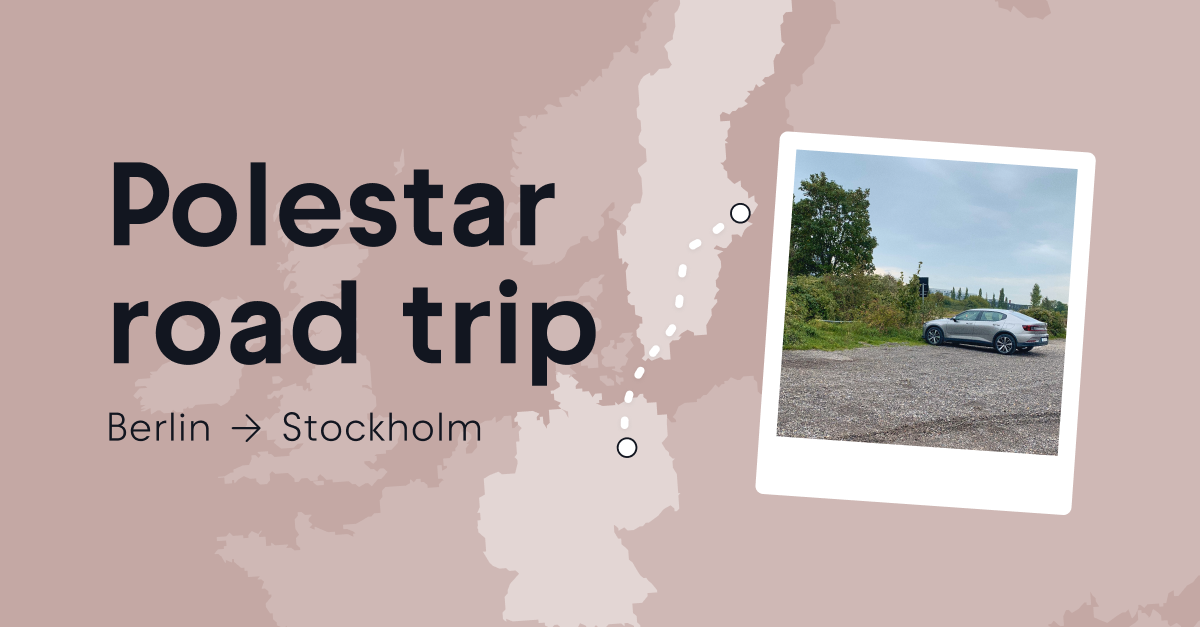When you decide to get an electric car, you will often hear that it’s the end of spontaneous driving. You will go on that road trip, get stuck in the middle of nowhere with an empty battery with no one else but yourself to blame.
We at Plugsurfing try to dispel this sentiment. We believe that with a Plugsurfing charging key in your pocket and access to thousands of reliable chargers across Europe at your fingertips, you have nothing to worry about.
But you can’t preach what you haven’t tried yourself.

Plugsurfing goes on a road trip
This autumn our marketing team decided it was time to put our charging beliefs to the test.
We are lucky to have many great carmakers as customers. What’s a better opportunity than a road trip to showcase them! For this journey, we teamed up with Polestar to test-run their new Polestar 2.
I was excited to get the opportunity to do the drive myself. As a fresh owner of an EV, I tried a few longer trips over the summer and was keen to compare experiences.
Ready, set, go
Our plan was to do a weekend drive. Because of the time constraint, we went for the most straightforward route from Berlin to Stockholm. According to Google Maps, it’s a little over 1,000km and could be driven in less than 13 hours. With stops for rest and charging, it meant between 6 to 8 hours of driving per day.
We will leave Berlin on Saturday morning and arrive in Stockholm by Sunday evening. There is one additional challenge. Since not all hotels or campsites offer onsite charging, we decided to rely on fast public chargers. For this journey, we will also use only Plugsurfing to charge.
On a good day and fully charged, our Polestar 2 should have up to 540km range. As long as you have a destination and a route in mind, you can rely on the car to get you there with battery range to spare. Polestars come with in-car integration of Google Maps and the abetterrouteplanner app. The route planner recalculates your forecasted arrival range as you go, depending on your speed, traffic, and weather conditions. When the car range dips below 15%, you will get an alert to charge and recommendations for nearby chargers. We found this feature to be extra useful in unfamiliar locations.
Day 1
Our plan for the day is to drive from Berlin to the island of Rugen, take a ferry from Sassnitz to Ystad, and push onwards to Helsingborg. There is only one ferry per day, so our challenge is to get to Sassnitz before 2.30pm or risk an overnight stay.
We will have to drive 300km to get to the ferry. Our Polestar’s battery is at 58%, so we have to top it up before departure. After a 30min charge in Prenzlauer Berg, we leave Berlin with 70% and an estimated range of 280km, which means we will have to do a quick charge on the way. Rugia has beautiful landscapes but lacks a good charging infrastructure. Since we are strapped for time, we plan to stop at Ionity in Völschow, some 200km away.
It’s a lovely autumn Saturday, and many Berliners are heading to the seaside for a weekend getaway. Stuck in traffic on the outskirts of Berlin, we get on the highway two hours behind schedule. Even though it’s still September, the air is crispy, and we have the heating on, which is putting a drain on the battery.
With 4% left, we arrive at the Ionity charging station at 12.50. At this point, we are trying to optimize the range we need to reach our destination. Luckily with 300kw charging capacity, the car charges fast, and we are back on the road in less than 15 minutes.
Driving too fast will eat into our range, so we stick to 110km/h, an upper limit of the optimal speed for an EV. The golden rule for driving an electric car is to keep the speed limit between 90 and a maximum of 110km/h. The luck is on our side. After a stressful yet stunning drive, we make it to the ferry with a few minutes to spare, 12% battery, and a 60km range.
Ystad has several options for fast charging, so we decide to stop there to charge and check out the sites. After the charge, we will have another 117 kilometers to Helsingborg, where we overnight.
Day 2
We have arrived in Helsingborg in the late evening with a 15% battery. Too tired to look for a charger, we dropped the car off at a parking lot and headed to the hotel. In the morning, we take a short drive to the harbor and put the car to charge for about 1h 30min, hoping to get it up to 80%. There are several empty chargers, but we have to try a couple of them before finding one that holds the charge. We leave the car and go to explore the city.
Taking the time to walk around and experience Helsingborg means that we end up leaving the city in the early afternoon. Our initial plan is to stop in Gränna, a cute little town that invented Polka Gris.
A road trip would not be complete without spontaneous detours. We spot a fish kiosk on the side of the road and decide to make a pit stop. Unfortunately, it doesn’t offer car charging, so we will have to top up on the way.
With 20% battery, we arrive at a busy gas station with Ionity chargers on site. It’s a busy day for Polestar. 3 out of 4 spots are occupied by Polestar 2 drivers. The only free charger doesn’t work, so we hope that one of the fellow drivers will be done soon. There is another 50kWh fast charger nearby, which we could use if it wasn’t blocked by ICEs.
A spot opens up, and we plug in. Since all the charging spots are occupied (by Polestars), we all charge slower than usual. After a quick top-up, we decide to try our luck at an Ionity charger in Gränna and head out.
Gränna’s charging station is also packed, but at least it comes with a beautiful view. We leave the car to get up to 70% charge and take this chance to check out the town.
After 1.5 days of driving, we are eager to reach our destination a little faster. Pushing the car speed to 120km/h increases our battery burn rate from 18-20kwh to 26kwh.
It’s time for a final push towards Stockholm. We make one last stop at an Ionity station in Norrköping. Luckily, there is one spot left. The rest of the chargers is occupied by a group of EV drivers who are trying to get their cars charged to a 100%. Going for a 100% charge is uneconomical, inefficient, and prevents a fast turnaround at chargers.
With 17% battery left, we make it to our hotel in Solna. While this was a fun drive, we are looking forward to not having to drive for the third consecutive day.
What we learned
Slow charging overnight will give you more opportunities for spontaneous detours during the day. While entirely possible, resorting to fast, public chargers meant that we often left late and had to race the clock.
If you are driving during the weekend or seasonal holidays, prepare to wait at the charging stops. Seek alternatives even if it takes you off the route. Periodically check which chargers are available. For a car like Polestar 2, with a 77kWh battery, charging at ultra-fast chargers is preferable. If you stop at a 50kW charger, plan to explore the city or have lunch nearby.
To optimize charging time, drive down to 10-15% of the battery and charge it up to a maximum of 60-75%. Charging from 80% to 100% will take as long or longer than the initial charge.
The verdict
We had no problem completing the drive using only fast public chargers. Using the Plugsurfing charging key, we could easily charge anywhere in Germany and Sweden. While we encountered faulty or busy chargers, there was always another available charging station nearby.
The majority of ultra-fast chargers are located near the highways for the sake of convenience. While it’s great to just pop in and charge, we would like to see more fast chargers located in the center of nearby towns or villages, which would offer a possibility to explore the area.

